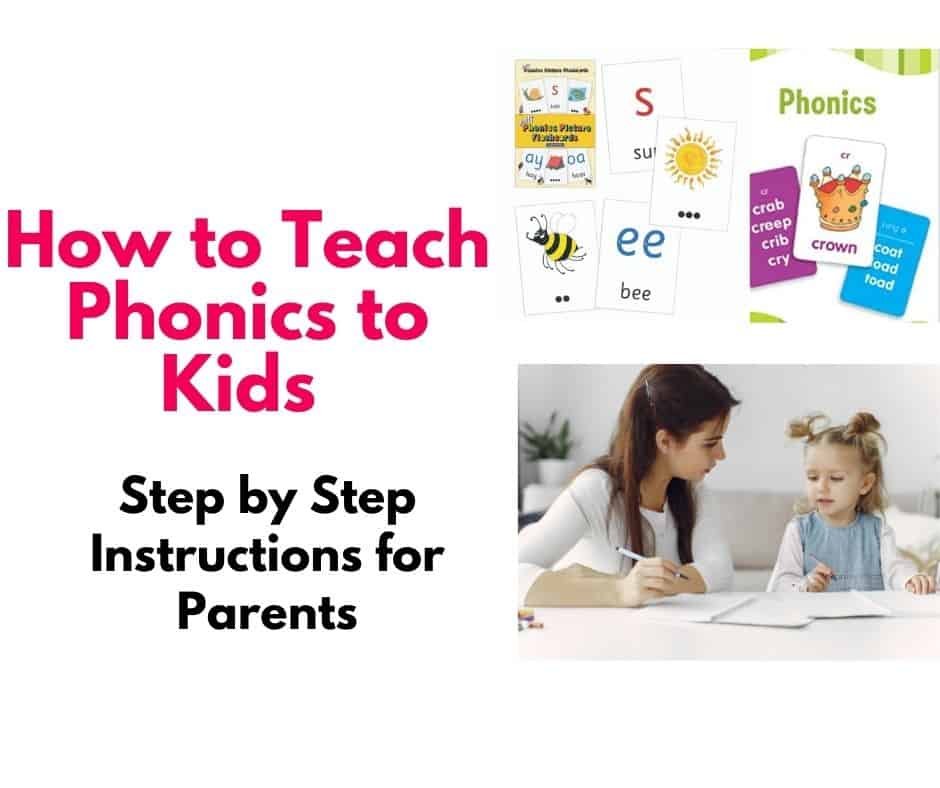
Looking for fun and engaging ways to teach your kids about diphthongs? Look no further! This article has got you covered with a variety of activities and product recommendations that will keep your kids excited and motivated to learn. Get ready to dive into the world of diphthongs with your little ones!
Diphthongs are an important part of phonics and can be tricky for kids to understand. As a phonics expert, I understand the challenges of teaching diphthongs to kids. But with the right techniques and resources, it can be made fun and engaging. In this guide, I will share effective methods for teaching diphthongs to kids, along with product recommendations to help make the learning process easier and enjoyable for both you and your child.
So let’s get started and discover the world of diphthongs together!
Also Read – How to Teach Phonics to Kids (Step by Step Instructions for Parents)
What are Dipthongs?
Diphthongs are two vowel sounds that are pronounced as a single sound. They are unique because the sound changes as the mouth moves during pronunciation.
When spoken, the sound of a diphthong glides or slides from one vowel sound to another. Examples of diphthongs include “oi” in “boil,” “ou” in “house,” and “ow” in “grow.” Diphthongs are unique because they involve a combination of two vowel sounds that create a ne
Diphthongs are different from vowel digraphs, which are also made up of two vowels, but they make a single sound that is different from the individual vowel sounds. There are several diphthongs in the English language, and they can be tricky for kids to learn because they involve blending two sounds together.
What is the difference between diphthongs and vowel digraphs?
Diphthongs and vowel digraphs are two different types of vowel combinations that can be found in words.
A diphthong is a combination of two vowel sounds within the same syllable. When spoken, the sound of a diphthong glides or slides from one vowel sound to another. Examples of diphthongs include “oi” in “boil,” “ou” in “house,” and “ow” in “grow.” Diphthongs are unique because they involve a combination of two vowel sounds that create a new, distinct sound.
A vowel digraph, on the other hand, is a combination of two vowels that represent a single sound or phoneme. Unlike diphthongs, the two vowels in a digraph are not pronounced separately, but instead represent a new sound. Examples of vowel digraphs include “ee” in “feet,” “ea” in “meat,” and “ai” in “train.”
To summarize, the main difference between diphthongs and vowel digraphs is that diphthongs involve two vowel sounds that glide or slide together to create a new sound, while vowel digraphs involve two vowels that represent a single sound or phoneme. Understanding the difference between these two vowel combinations is important for teaching phonics to young children and helping them develop their language skills.
What is a syllable
A syllable is a unit of sound that forms a word or part of a word. It is typically composed of one or more vowel sounds and the consonants that follow or precede them. In simpler terms, it is a beat or unit of rhythm that helps to form words. For example, the word “apple” has two syllables: “ap” and “ple”. Each syllable contains a vowel sound, and the consonants that come before and after the vowel sound create the syllable. The number of syllables in a word determines its pronunciation and helps with reading and spelling.
Diphthongs examples
here are some examples of common diphthongs in English:
- “oy” – as in “boy”
- “ow” – as in “cow”
- “oi” – as in “join”
- “ou” – as in “house””
- “ew” – as in “few”
- “ou” – as in “out”
- “ow” – as in “how”
Note that the vowel digraphs “ai”, “au”, “ei”, and “ie” have been removed from this list, as they are not diphthongs.
Vowel Digraph examples
Here are some examples of common vowel digraphs in English:
- “ai” – as in “train”
- “ea” – as in “eat”
- “ee” – as in “seed”
- “oa” – as in “boat”
- “oo” – as in “moon”
- “ie” – as in “pie”
- “ue” – as in “blue”
- “ei” – as in “veil”
- “ui” – as in “fruit”
Note that the diphthongs “oi”, “ou”, and “ow” have been removed from this list, as they are not vowel digraphs.
What should my child know before I can start teaching diphthongs?
Before starting to teach diphthongs to your child, it is important for them to have a basic understanding of phonics and phonemic awareness. Here are a few concepts your child should know before starting to learn diphthongs:
- Letter-sound correspondence: Your child should be able to identify and associate individual letters with their corresponding sounds.
- Short and long vowel sounds: Your child should be able to differentiate between short and long vowel sounds. This will help them understand the differences between individual vowel sounds and the combination of sounds that make up diphthongs.
- Consonant blends and digraphs: Your child should be able to identify and differentiate between consonant blends and digraphs. This will help them understand the concept of two or more sounds coming together to create a new sound.
Once your child has a basic understanding of phonics and phonemic awareness, you can start introducing diphthongs. Remember to start with easier diphthongs such as /oi/ or /ow/ before moving on to more complex ones like /aɪ/.
These workbooks are a great resource for parents who want to help their child build a solid foundation in phonics and phonemic awareness. The workbook includes lessons and activities that cover letter recognition, letter sounds, and phonemic awareness, which are essential skills for learning diphthongs.
Also Read – Top Strategies for Teaching Consonant Blends to Kids: A Comprehensive Guide
Are there any examples of vowel combinations that are not diphthongs or vowel digraphs
Here are some examples of other types of vowel combinations that are not diphthongs or vowel digraphs:
- Vowel blends: In some cases, two vowel sounds may appear together in a word, but they are pronounced separately and do not form a distinct sound. This is known as a vowel blend. Examples of vowel blends include “io” in “pioneer” and “ue” in “plague.”
- Silent vowels: Sometimes, a vowel sound may be written in a word, but it is not pronounced. This is known as a silent vowel. Examples of silent vowels include the “e” in “bike” and the “u” in “guard.”
- R-controlled vowels: When a vowel is followed by the letter “r,” it can create a unique sound that is different from both a pure vowel sound and a diphthong. This is known as an r-controlled vowel. Examples of r-controlled vowels include “ar” in “car” and “er” in “her.”
- Schwa sound: The schwa sound is the most common vowel sound in English, and it is represented by the symbol “É™”. The schwa sound is often found in unstressed syllables and is pronounced as a very short, neutral vowel sound. An example of a word with a schwa sound is “sofa,” where the first syllable is pronounced with a schwa sound.
Understanding these different types of vowel combinations can help children develop their phonics skills and become better readers and spellers. We will cover these later.
Also Read – Fun and Easy Ways to Teach Digraphs to Kids:. Discover the Secret Code of Sounds
List of diphthongs words
- oi (as in oil): boil, coil, toil, soil, spoil, broil, coin, foil, joint, point, voice
- oy (as in boy): toy, joy, royal, loyal, annoy, boyhood, destroy, oyster, ploy, soybean
- au (as in author): pause, cause, autumn, August, laundry, applaud, causeway, fault, sausage, taut, vault
- aw (as in saw): law, raw, crawl, paw, draw, awe, awkward, claw, crawl, jaw, straw
- ow (as in cow): now, how, brown, town, crowd, bellow, bow, glow, plow, row, show
- ou (as in out): house, mouse, about, shout, count, blouse, doubt, drought, foul, scout, sprout
- ue (as in blue): clue, blue, due, true, rescue, blueberry, glue, hue, rescue, statue, truest
- ui (as in juice): fruit, juice, suit, recruit, pursuit, bruise, cruise, fruit, juice, ruin, suit
- ew (as in new): new, few, chew, crew, dew, chewy, drew, flew, knew, screw, stew
Fun and engaging phonemic awareness activities for teaching diphthongs (How to teach Diphthongs to kids)
Diphthongs are a combination of two vowel sounds pronounced together within a single syllable. They are an important aspect of the English language and play a significant role in shaping our communication. Teaching your kids about diphthongs can be both fun and engaging, especially if you incorporate interactive activities. Here are some ideas to get started:
Diphthong Scavenger Hunt
For this activity, you will need to hide pictures or objects around the room that contain diphthongs. Some good options for hiding might be a toy cow for the “ow” sound or a coin for the “oi” sound.
To start, give the children a brief explanation of diphthongs and then send them on their scavenger hunt. When they find an object, have them say the diphthong sound aloud.
Product Recommendation: You can use these cards to help with the scavenger hunt.
Diphthong Bingo
For this activity, create a bingo board with different diphthongs written in the squares. You can use the same diphthongs as listed above. Then, call out words that contain diphthongs and have the children mark the corresponding sound on their board. When someone gets a bingo, have them read the words aloud.
Diphthong Word Sort
For this activity, create a list of words that contain diphthongs. Then, have the children sort the words into categories based on the diphthong sound they hear. For example, they could sort “coin,” and “join” into the “oi” category. You can make this activity more engaging by using a colorful sorting mat or a word sorting game.
Another example, you can provide a list of words like “oil, coin, toy, boy, mouth, house” and ask your kids to sort them into two groups: those with the “oi” diphthong sound and those with the “ou” diphthong sound.
Diphthong Tic Tac Toe
For this activity, draw a tic tac toe board and write different diphthongs in the squares. Have the children take turns saying a word that contains the diphthong and placing their X or O in the corresponding square. This game can be played in pairs or small groups.
Diphthong Song
For this activity, create a simple song or chant that includes different diphthongs. For example, “When two vowels go walking, the first one does the talking, and that’s how you make a diphthong!” Sing the song or chant together and have the children practice saying the diphthong sounds.
Diphthong Charades
For this activity, have the children act out words that contain diphthongs while the others guess the word. For example, they could act out rowing a boat for the “ow” sound or holding up a coin for the “oi” sound. This activity helps children associate the diphthong sound with real-life actions and objects.
Diphthong Puzzles
For this activity, create simple puzzles using pictures of objects that contain diphthongs. Cut each picture into two pieces, one with the object and one with the diphthong spelling. Have the children match the two pieces together to complete the puzzle. This activity helps children associate the diphthong sound with its corresponding spelling.
Diphthong Word Building
For this activity, write words containing diphthongs on index cards, but leave out the diphthong sound. Have the children use letter tiles or magnetic letters to build the missing diphthong sound. This activity helps children practice spelling diphthongs and build their phonemic awareness skills.
Diphthong Board Game
For this activity, create a simple board game with spaces that contain diphthongs. Have the children roll a dice and move their game piece to the corresponding space. When they land on a space with a diphthong, they must say a word that contains that diphthong. This game can be played individually or in small groups.
This game involves building words using letter tiles, with a focus on phonics and word families. You can use this game to teach diphthongs by choosing tiles with words that contain diphthongs. For example, you can choose a tile with the word “coin” and teach the diphthong “oi.” Encourage your kids to say “oi” each time they see the word on the tile.
Diphthong Hopscotch
For this activity, create a hopscotch grid with different diphthongs written in each square. Have the children hop from square to square, saying the diphthong sound aloud. This activity helps children associate the diphthong sound with physical movement and reinforces their memory of the sound.
Diphthong Memory Match
For this activity, create pairs of cards with pictures of objects that contain diphthongs. Have the children turn over two cards at a time to see if they match. When they find a match, they must say the word aloud. This activity helps children practice recognizing diphthongs and their corresponding spelling.
Diphthong Storytelling
For this activity, have the children create a story using words that contain diphthongs. Encourage them to use their imagination and include as many diphthongs as they can. This activity helps children practice using diphthongs in context and builds their storytelling skills.
These books have stories that focus on diphthongs and r-controlled vowels. As a phonics expert, you can read the stories to your kids and have them repeat the diphthong sounds. For example, you can read a story about a boy who enjoys playing with toys and teach the diphthong “oy.” Encourage your kids to say “oy” each time they hear it in the story.
Singing
Kids love music, so incorporating songs into your teaching can make learning diphthongs more enjoyable.
The Phonics Songs CD like these have catchy tunes that teach kids about various phonics rules, including diphthongs. You can encourage your kids to sing along with the CD and repeat the diphthong sounds.
For example, you can start with the diphthong “oi” and use the song “Boink, Boink” to teach it. Encourage your kids to sing along and say “oi” each time they hear it in the song.
Flashcards
Flashcards are an effective tool for helping kids memorize diphthongs.
This set has cards that feature pictures and words with diphthongs highlighted. As a phonics expert, you can use these flashcards to teach kids about diphthongs by showing them the picture, saying the word, and having them repeat the diphthong sound. For example, you can use the card with a picture of a coin and teach the diphthong “oi.” Ask your kids to repeat the sound after you say “oi” each time you point to the picture
Sentence building
Sentence building is a great way to reinforce diphthongs and their use in context. You can provide your kids with a set of sentence strips that contain words with diphthongs. Encourage them to read the sentences and highlight the diphthongs. Then, have them use the sentences to build new sentences by replacing the words with other words that contain diphthongs.
For example, you can provide a sentence like “The toy boat floats on the oil slick” and have your kids replace “toy” with “coin” and “oil” with “boy” to make a new sentence.
Rhyming games
Rhyming games can help kids identify and practice diphthongs. You can play a rhyming game with your kids by providing them with a list of words that contain diphthongs and asking them to come up with other words that rhyme. For example, you can provide the word “mouse” and ask your kids to come up with words that rhyme, like “house” and “blouse.”
Online resources
There are many online resources available that can help kids learn about diphthongs.
Here are some additional practical tips for teaching diphthongs to children:
- Make it visual: Use pictures or visual aids to help children associate the sound of diphthongs with the corresponding spelling. This can be especially helpful for children who are visual learners.
- Practice makes perfect: Encourage children to practice saying words with diphthongs as much as possible. The more they practice, the more confident they will become in their ability to recognize and use diphthongs.
- Use games and activities: As mentioned earlier, games and activities can be a great way to make learning diphthongs fun and engaging for children. Incorporating different types of games and activities can help keep children interested and motivated.
- Provide feedback: When children are practicing saying words with diphthongs, provide feedback and corrections as needed. This can help children develop their phonemic awareness skills more effectively.
- Keep it age-appropriate: It’s important to keep in mind the age and developmental level of the children you are working with. Adjust your teaching methods and activities to suit their needs and abilities.
- Build on prior knowledge: When introducing diphthongs, it can be helpful to build on children’s prior knowledge of vowel sounds and phonics. This can help children make connections and understand the new concepts more easily.
By following these tips and incorporating fun and engaging activities, you can help children develop their phonemic awareness skills and become confident readers and spellers.
Incorporating these additional tips into your teaching can help your kids master diphthongs and other important phonics concepts. By making learning fun and engaging, you can help your kids develop strong language skills that will serve them well in the future.
What are some effective ways to teach diphthongs to children?
There are many effective ways to teach diphthongs to children. Here are a few:
- Use visual aids: Using pictures or other visual aids can help children associate the sound of diphthongs with the corresponding spelling. The Magnetic Phonics Set from Learning Resources is a great product for visual learners. The set includes 63 pieces that can be used to create words with different phonetic sounds, including diphthongs.
- Practice, practice, practice: Encourage children to practice saying words with diphthongs as much as possible. You can use flashcards or worksheets to help children practice identifying and using diphthongs. These Phonics Flashcards include diphthongs along with other vowel sounds.
- Use games and activities: Incorporating games and activities can help make learning diphthongs fun and engaging for children. These bingo games are a great option. The game includes 36 playing cards and caller’s mat with pictures and words that feature different diphthongs.
How can I help my child distinguish between diphthongs and vowel digraphs?
Distinguishing between diphthongs and vowel digraphs can be challenging for children. Here are some tips to help:
- Start with simple examples: Begin by introducing children to simple examples of diphthongs and vowel digraphs. For example, show them the word “coin” and explain that the “oi” makes a diphthong sound. Then show them the word “boat” and explain that the “oa” makes a vowel digraph sound.
- Use visual aids: Visual aids can be especially helpful for distinguishing between diphthongs and vowel digraphs. For example, you can use pictures to show the difference between a “o” and “u” diphthong versus a “oo” vowel digraph.
- Practice, practice, practice: Encourage children to practice saying words with diphthongs and vowel digraphs as much as possible. You can use worksheets or flashcards to help children practice identifying and using these sounds. The Phonics Flashcards from Carson Dellosa Education include both diphthongs and vowel digraphs.
What are some common words that feature diphthongs?
Here are some examples of common words that feature diphthongs:
- coin
- boy
- out
- mouse
- pie
- house
- cloud
- toy
What age is appropriate to start teaching diphthongs?
Children can start learning about diphthongs as early as preschool or kindergarten. However, the specific age may vary depending on the child’s development and phonemic awareness skills. As a general rule, children should have a basic understanding of vowel sounds before learning about diphthongs. It’s important to adjust your teaching methods and activities to suit the age and developmental level of the children you are working with.
In conclusion, teaching diphthongs is an important aspect of phonics instruction that can greatly benefit young readers. By using engaging and fun activities, such as games and songs, children can learn to recognize and differentiate between diphthongs in words.
It’s important to start with a solid foundation in phonemic awareness and basic phonics concepts, such as CVC words and consonant blends, before moving on to more complex topics like diphthongs.
I recommend incorporating a variety of teaching methods and resources, including books, online tools, and educational apps, to keep your child engaged and motivated. By providing a strong phonics foundation and making learning fun, you can help your child become a confident and skilled reader.







